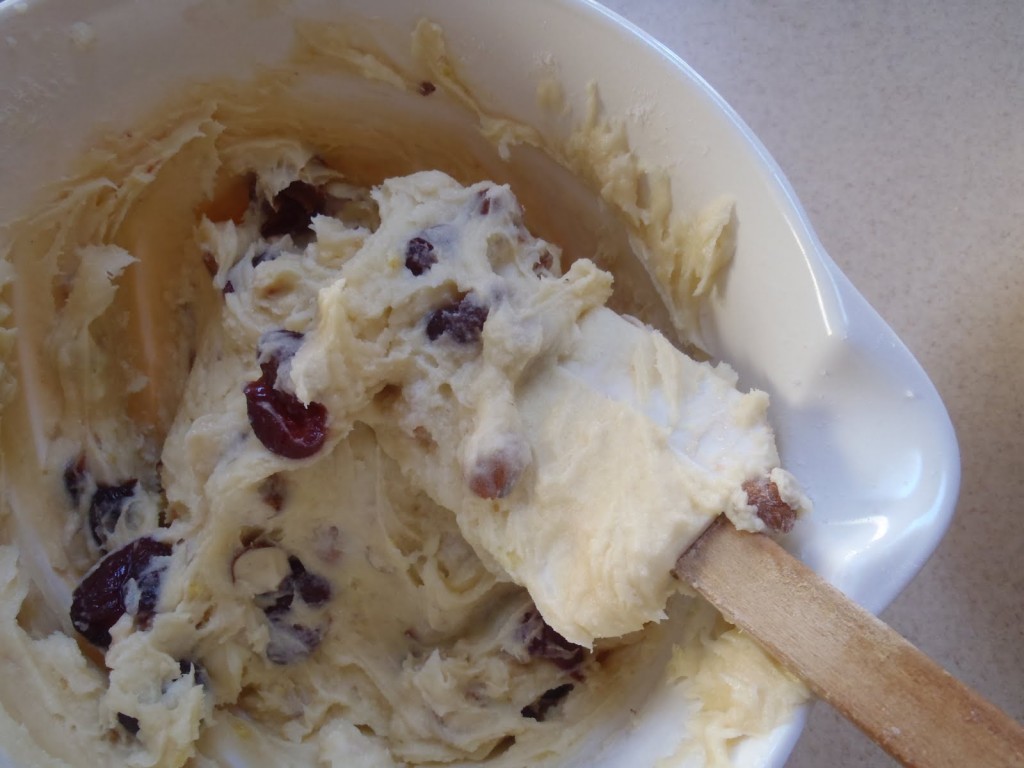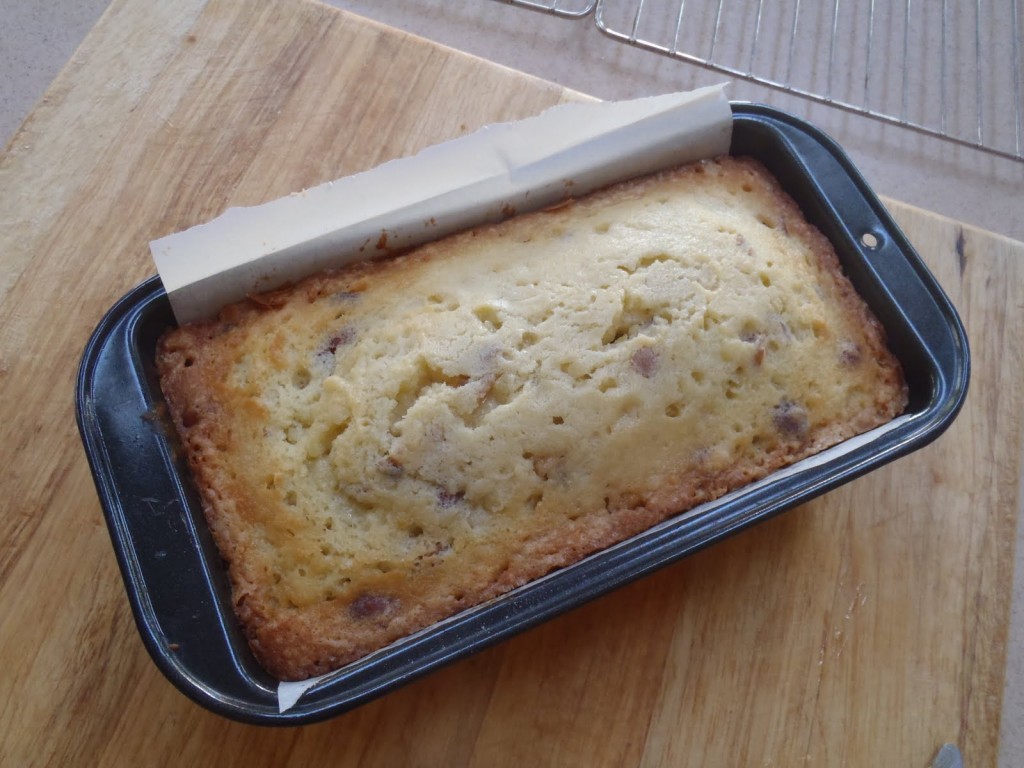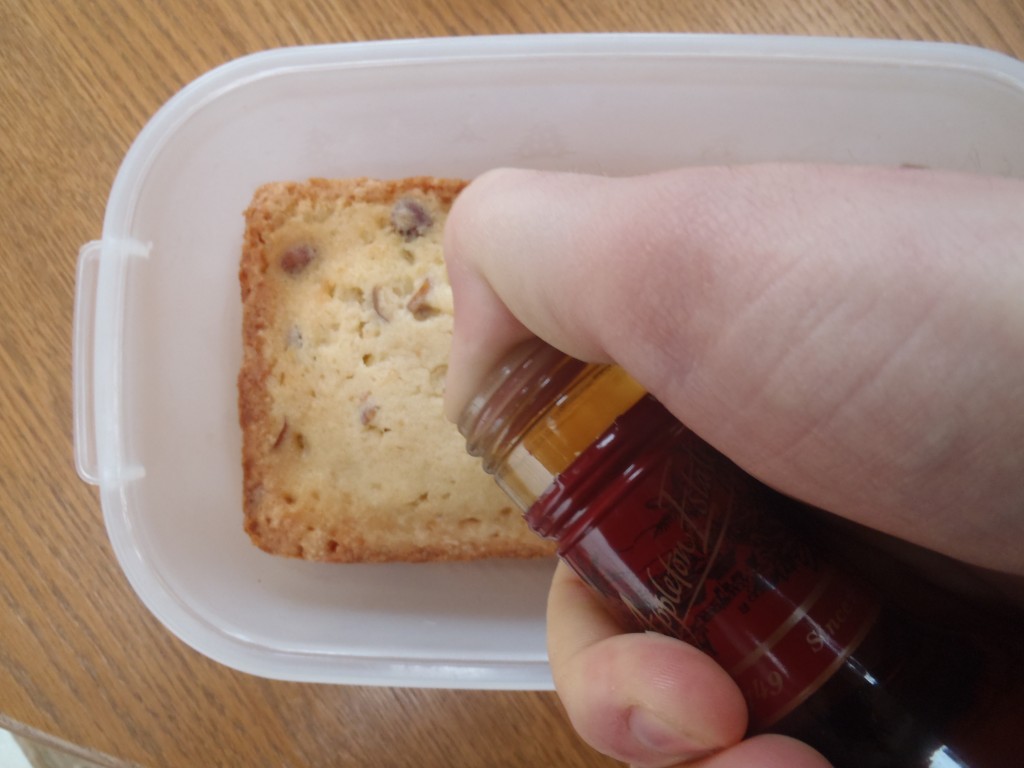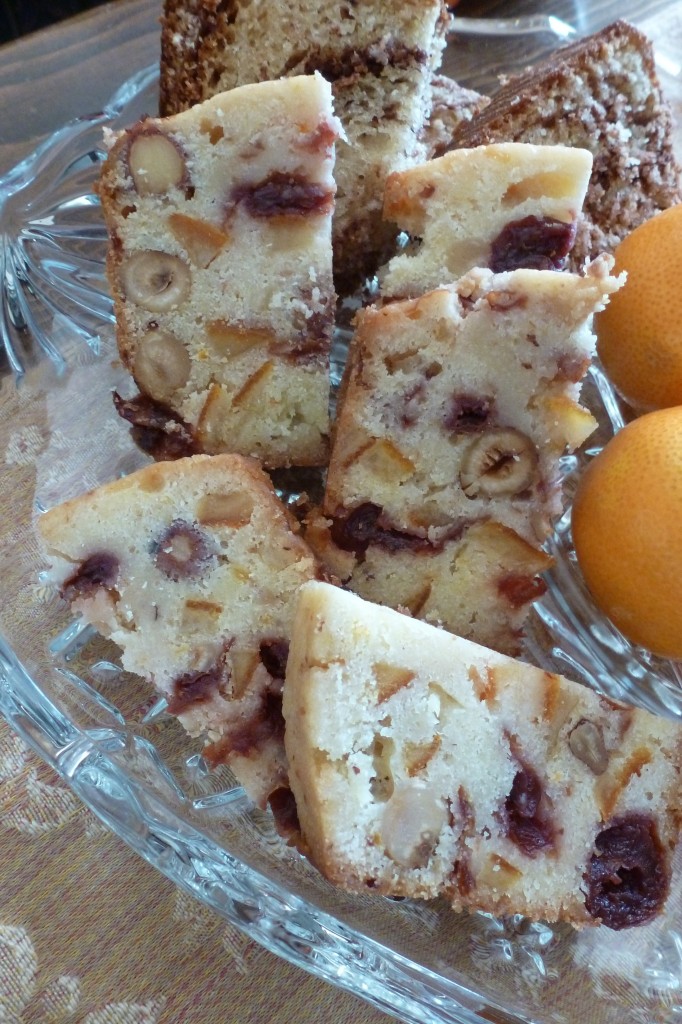The waiting is the hardest part.
-Tom Petty and the Heartbreakers
I used to revile fruitcake, but in recent years a description by Jeffrey Steingarten has made me more receptive to the dish.
…full of dark, saturated medieval tastes and colors… aged for a year and then set aflame at the very last minute, carefully spooned out like the treasure it is…
I became mildly interested in the idea of aging baked goods, but I still regarded fruitcake as a gaudy curiosity. Then I came across fruitcake in the memoirs of a woman who grew up during the depression in Northern Ontario, called On Turnips, Teas, and Threshing Bees. Her description of fruitcake, and the lengths her family went to prepare it, surprised me. They started collecting ingredients early in the fall, candying ripe fruit. Later in the year they had to seed all the Muscat raisins and crack the walnuts by hand.
Even the eggs were a luxury. Apparently chickens have only recently decided to lay eggs all year long (persuaded by better feed and warmer barns?). Her family preserved the last of the fall’s eggs expressly for the Christmas fruitcake. They kept them in a jelly she called water glass, which is sodium silicate. Storing the eggs for months was a considerable sacrifice for her family, as during the depression eggs were one of the few bartering items they had to trade for necessities like flour.
Living in the Canadian shield, spruce was the main wood for ovens and furnaces. Hardwood was comparatively rare, but a few chosen logs were set aside for the fruitcake, which needed to bake at low temperatures. They cherished this cake.
I decided to reconsider my position on fruitcake this year with a simple trial: a single loaf with glacé cherries, candied orange and lemon peel, and hazelnuts.
Glacé cherries
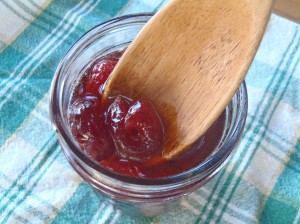 “Glacé” is a confusing term because it can refer to ice cream, cake frosting, fruit candied in “hard crack” syrup, or simply fruit preserved in syrup. It’s that last definition that applies here. Most sources I consulted had a similar procedure for making glacé cherries:
“Glacé” is a confusing term because it can refer to ice cream, cake frosting, fruit candied in “hard crack” syrup, or simply fruit preserved in syrup. It’s that last definition that applies here. Most sources I consulted had a similar procedure for making glacé cherries:
Make a simple syrup of one part water and one part sugar. Bring to a simmer, add pitted cherries, remove pot from heat, cover and let stand over night. This is simply to infuse the syrup with cherry, and the cherries with syrup. The next day, remove the cherries and reduce the syrup until a candy thermometer reads 230F. This gives a good thick-but-runny consistency. Reintroduce the cherries, simmer briefly, then store in a sanitzed jar.
I used our local evans cherries instead of the BC bings. They were so soft after the glacé process I worried they would be too delicate to fold into the dense pound cake batter. While they definietly don’t hold their round shape like the bings, they managed to stay in one piece. Their tartness is a welcomed addition to the cake.
Candied Peel
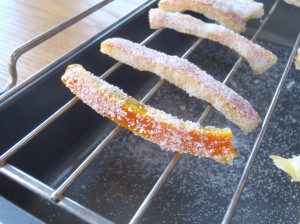 Candied peel is dead simple to make. Remove the peel from lemons and oranges. Use proper, thick-skinned oranges like navel, not thin-skinned mandarins. Cut into strips.
Candied peel is dead simple to make. Remove the peel from lemons and oranges. Use proper, thick-skinned oranges like navel, not thin-skinned mandarins. Cut into strips.
The peel is usually blanched to remove some of the bitterness of the pith (the fleshy white part). Put the peels in cold water and bring to a boil. Strain and repeat. Strain and repeat. After blanching, boil the peels in simple syrup until translucent (see left). Remove and roll in sugar. Soak the peels in water or liquor before folding into the cake batter.
Batter
I made a simple, dense, pound cake of equal parts butter, sugar, eggs, and flour, by weight. If you cream the butter and sugar well enough, there’s no need for baking powder. I added the zest of one lemon, then folded in my cherries, candied peel, and hazelnuts.
The doneness of the cake depends on how you intend to store the specimen until Christmas. If you’re just throwing it into the fridge, it’s important that you slightly under-bake the cake, so that it remains moist. If you’re going to be steeping the cake in alcohol, bake the cake as you normally would, until a knife inserted in the middle comes out clean.
Aging
If you’re taking the alcoholic route, keep your cake in a non-reactive container at room temperature. Every couple of days, sprinkle rum or brandy onto the top and sides of the cake. Alton Brown uses a spray-bottle to achieve a uniform mist of liquor. I partially block the bottle opening with my thumb and pour.
Results
After a few weeks aging, the cake is dense, moist, and redolent of fruit peel and rum. It’s remarkable how the flavours develop over the weeks. This is definitely going to be a tradition in my house.
Maybe next year I can use beaked hazelnuts from the river valley…
Ingredients
- 8 oz unsalted butter, cubed
- 8 oz granulated sugar
- 8 oz eggs
- 8 oz all-purpose flour, sifted
- 1 tsp kosher salt
- 1 orange, zested and juiced
- 5 oz roasted, skinned hazelnuts
- 5 oz glacé evans cherries, strained from liquid
- 5 oz candied orange peel
- approximately 1 cup of fine, spiced rum
Procedure
- Preheat oven to 325°F.
- Thoroughly butter the base and sides of a ceramic terrine and line with parchment.
- Combine butter and sugar in the bowl of a stand mixer. Cream with the paddle attachment until light and fluffy, about five minutes. Start on a low speed, and once the sugar and butter have combined, turn to medium-high.
- With mixer still running, add the eggs one at a time, allowing each to be fully incorporated before adding the next. Add the orange zest and juice.
- Turn the mixer to the lowest speed. Slowly add the flour. Stop the mixer as soon as all the flour is incorporated into the batter. Do not over-mix.
- Fold in the hazelnuts, cherries, and candied peel.
- Transfer the batter to the prepared terrine. Bake in the 325°F oven until the top of the cake is domed and brown, and a toothpick inserted in the centre comes out clean, roughly 60 minutes.
- Remove the cake from terrine and cool on a wire rack.
- Once cooled. Transfer the cake to a container with an airtight lid.
- Store the cake at a cool room temperature, about 15°C. Every other day for 1 month sprinkle 1 tbsp of rum over the cake, getting the liquor on all the surfaces. I affectionately refer to this as feeding the fruitcake.
